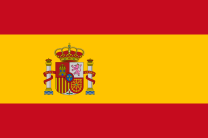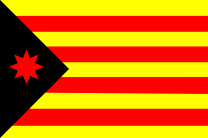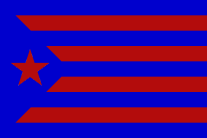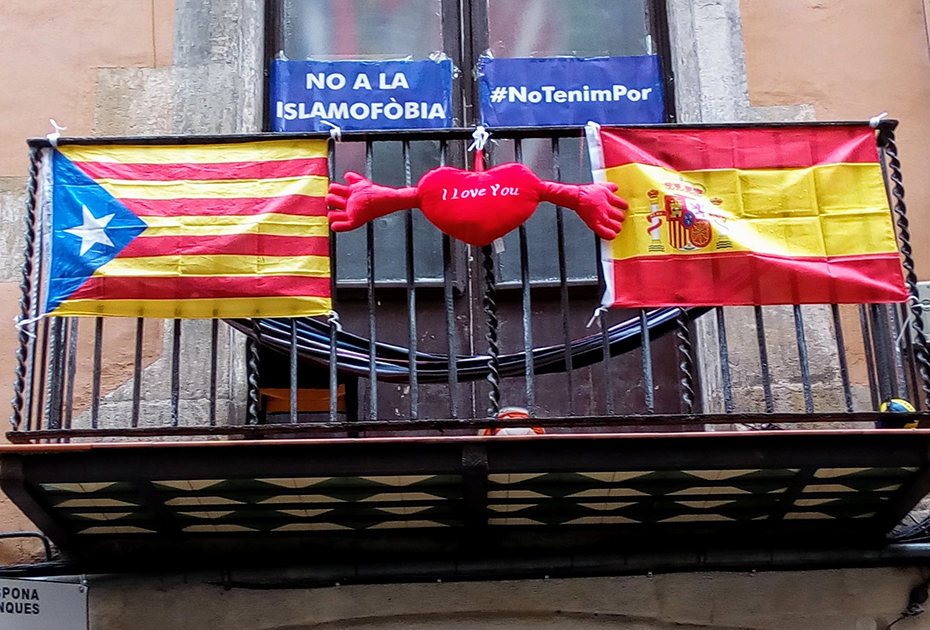[Originally published in Art4d Magazine]
Barcelona is currently festooned with flags hanging from apartment balconies. It’s been this way especially since 2010, when the Spanish Constitutional Court in Madrid, responding to a legal challenge presented by the then recently elected Popular Party of Spain, overturned several articles of the 2006 Statute of Autonomy of Catalonia, including a particularly contentious one that made reference to Catalonia as a “nation.” This statute had previously been passed by the legislature of Catalonia and the parliament of Spain, and ratified in a referendum by the Catalan electorate, so its modification by the Spanish Constitutional Court was insulting for many Catalans, triggering the resurgence of a relatively dormant independence movement. What followed were countless mass demonstrations, a non-binding independence referendum in 2014, and the more recent illegal referendum of October 1st, the violent images of which we’ve all seen. During these years, flags of all kinds became visible all over the city, causing a great deal of confusion among foreign visitors. The following is a guide explaining the most commonly displayed flags.
 The official flag of Spain —a broad gold-yellow stripe with a crest over a red background— is referred to as la Rojigualda, and is unofficially displayed by Spanish nationalists opposed to Catalan independence. Originally designed as a banner to improve the visibility of sailing ships at sea, it is required by law to be flown over all official buildings housing representatives of Spain’s central authorities, causing resentment among Catalans who favor independence.
The official flag of Spain —a broad gold-yellow stripe with a crest over a red background— is referred to as la Rojigualda, and is unofficially displayed by Spanish nationalists opposed to Catalan independence. Originally designed as a banner to improve the visibility of sailing ships at sea, it is required by law to be flown over all official buildings housing representatives of Spain’s central authorities, causing resentment among Catalans who favor independence.
 The official flag of Catalonia is known as la Senyera, and has four parallel red stripes on a yellow background. Dating from Medieval times, it is one of the oldest official flags in Europe. By itself, it is neither pro- nor anti-independence, however it is often displayed unofficially in conjunction with the Spanish flag by those Catalans who assert a dual identity.
The official flag of Catalonia is known as la Senyera, and has four parallel red stripes on a yellow background. Dating from Medieval times, it is one of the oldest official flags in Europe. By itself, it is neither pro- nor anti-independence, however it is often displayed unofficially in conjunction with the Spanish flag by those Catalans who assert a dual identity.
The above two flags are official, however there are many unofficial flags –some historical; some modern variations of official flags– that can also be seen, especially at demonstrations or hanging from balconies of private dwellings.
 La Estelada is a Senyera to which a blue triangle containing a five-pointed white star has been added, symbolizing “freedom for Catalonia.” Its design was inspired by, and dates from, Cuba’s independence struggle, hence the resemblance. Some Catalan municipalities, as an act of resistance, display this flag in lieu of la Rojigualda, much to the resentment of Spanish nationalists.
La Estelada is a Senyera to which a blue triangle containing a five-pointed white star has been added, symbolizing “freedom for Catalonia.” Its design was inspired by, and dates from, Cuba’s independence struggle, hence the resemblance. Some Catalan municipalities, as an act of resistance, display this flag in lieu of la Rojigualda, much to the resentment of Spanish nationalists.
 Occasionally, it is possible to spot the red, yellow and violet striped flag of the short lived Second Spanish Republic, which was democratically proclaimed in 1931 and violently overthrown in 1939, when General Franco staged a coup d’état that resulted in the Spanish Civil War. During this period, Catalonia enjoyed a much higher degree of autonomy than it does at present. Today, it is flown mainly by Spanish leftists as a symbol of opposition to the Bourbon monarchy.
Occasionally, it is possible to spot the red, yellow and violet striped flag of the short lived Second Spanish Republic, which was democratically proclaimed in 1931 and violently overthrown in 1939, when General Franco staged a coup d’état that resulted in the Spanish Civil War. During this period, Catalonia enjoyed a much higher degree of autonomy than it does at present. Today, it is flown mainly by Spanish leftists as a symbol of opposition to the Bourbon monarchy.
 The yellow Estelada groga is a Senyera with a yellow triangle and a red star, signifying a leftist independent Catalan Republic. It also symbolizes the politically touchy idea of uniting the Països Catalans (areas in which Catalan is spoken): principally Andorra, Valencia and the Balearic Isles, but also the eastern strip of Aragon, Roussillon in southern France, and the city of Alghero on the island of Sardinia, Italy.
The yellow Estelada groga is a Senyera with a yellow triangle and a red star, signifying a leftist independent Catalan Republic. It also symbolizes the politically touchy idea of uniting the Països Catalans (areas in which Catalan is spoken): principally Andorra, Valencia and the Balearic Isles, but also the eastern strip of Aragon, Roussillon in southern France, and the city of Alghero on the island of Sardinia, Italy.

There is also an anarchist Estelada…

…an environmentalist Estelada verda…

…an Estelada culé for F.C. Barça fans…

…and an LGBT Estelada.
It would seem, alas, that there is a flag of every stripe in the current political conflict between Spain and the Catalan independence movement; surely a larger sign of the politically complex times we live in.
Source: Criticalista


